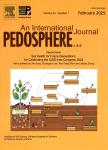Assessment of Plant-Driven Mineral Weathering in an Aggrading Forested Watershed in Subtropical China
Assessment of Plant-Driven Mineral Weathering in an Aggrading Forested Watershed in Subtropical China作者机构:State Key Laboratory of Soil and Sustainable AgricultureInstitute of Soil ScienceChinese Academy of SciencesNanjing 210008(China) University of Chinese Academy of SciencesBeijing 100049(China) Key Laboratory of Ecosystem Network Observation and ModelingInstitute of Geographic Sciences and Natural Resources ResearchChinese Academy of SciencesBeijing 100101(China) Section of Crop&Soil SciencesCornell UniversityIthaca NY14853(USA)
出 版 物:《Pedosphere》 (土壤圈(英文版))
年 卷 期:2016年第26卷第6期
页 面:817-828页
核心收录:
基 金:supported by the National Natural Science Foundation of China(Nos.41471176 and41130530)
主 题:biogeochemistry biomass Earth's Critical Zone geochemical mass balance nutrient absorption stoichiometric analysis,vegetation weathering mechanisms
摘 要:Plant growth contributes to mineral weathering, but this contribution remains poorly understood. Weathering rates in an aggrading forested watershed in subtropical China were studied by means of geochemical mass balance. Rainfall, dry deposition, and streamwater were monitored from March 2007 to February 2012. Samples of vegetative components, rainfall, dry deposition, streamwater, representative soils, and parent rock were collected and determined for mass balance calculation and clarifying plant-driven weathering mechanisms stoichiometrically. Ignoring biomass, weathering rates of Ca^2+, Mg^2+, Na^+, and Si were 25.6, 10.7, 2.8, and 51.0 kg ha^-1 year^-1, respectively. Taking biomass into consideration, weathering rates of Ca^2+, Mg^2+, and Si and the sum of weathering rates of Ca^2+, Mg^2+, Na^+, K^+, and Si were 2.6, 1.8, 1.2, and 1.5-fold higher than those ignoring biomass, respectively. This is attributed to plant-driven weathering due to the nutrient (e.g., Ca^2+, Mg^2+, and K^+) absorption by vegetation and substantial proton production during assimilation of these nutrients, with the former acting as a pump for removing weathering products and the latter being a source of weathering agents solubilizing mineral components. The same pattern of weathering, i.e., higher rates of weathering with than without including biomass in mass balance calculation, was reported in previous studies; however, the extent to which plants drive weathering rates varied with vegetation types and climatic zones. The documented biological weathering driven by plants is expected to play a critical role in regulating nutrient cycling and material flows within the Earth's Critical Zone.




